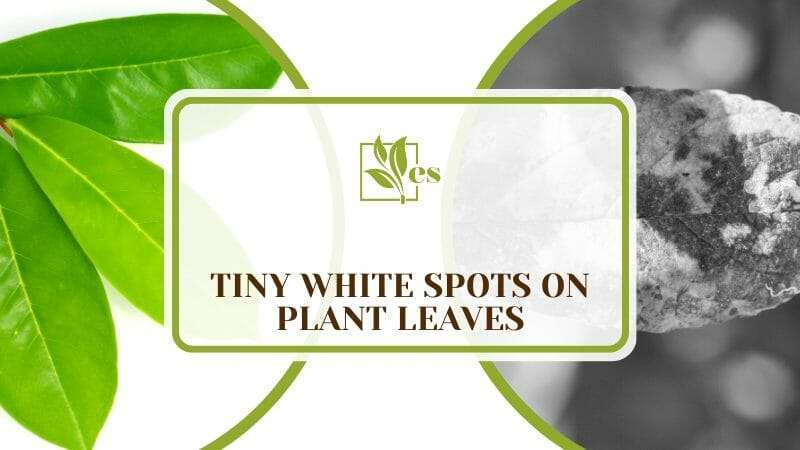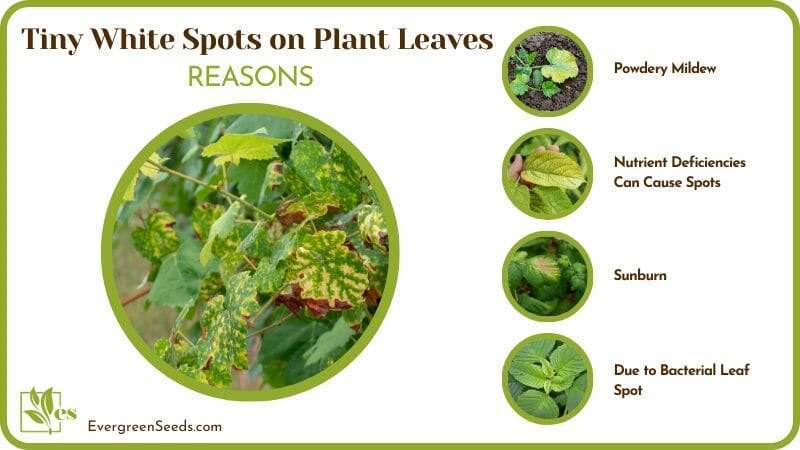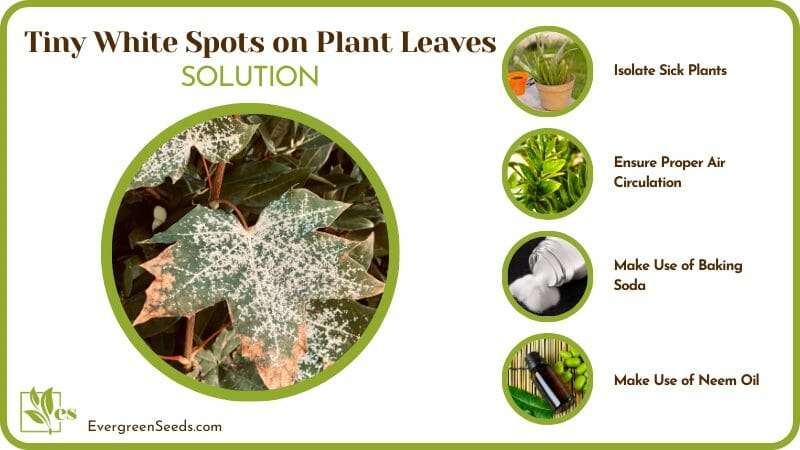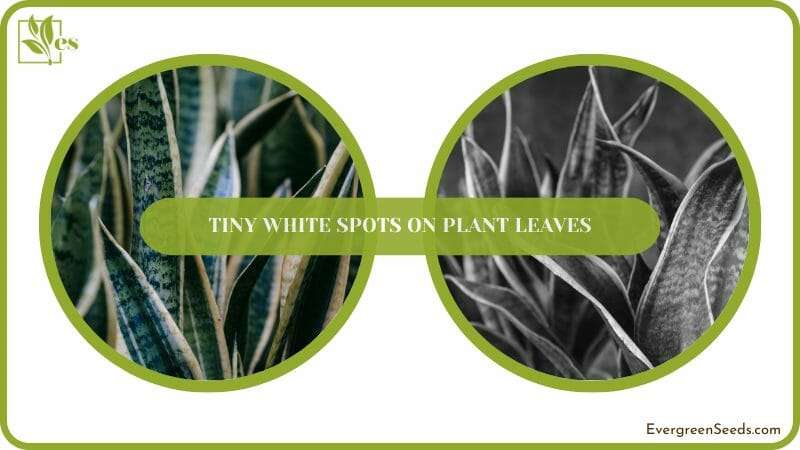Tiny white spots on plant leaves may or may not be a major cause for concern depending on the cause of the spots.

While the spots may just be paint or similar, they may also be a sign that your plant is deformed or has a nutrient deficiency.
Whatever the case, you need to get to the bottom of it. Read this article to know why your plant leaves have spots on them.
JUMP TO TOPIC
What Are Causes of Tiny White Spots on Plant Leaves?
The causes of tiny white spots on your plants include the attack of powdery mildew and downy mildew on the plants, nutrient deficiency, sunburn, pest attacks, exposure to chemicals, bacterial attack, etc. It could also just be paint on the leaves. You have to make sure and diagnose correctly.
– It Could be Powdery Mildew
Powdery mildew is a type of fungi that attacks plants, especially indoor plants. You should see white or gray spots or patches on the leaves of your plants. If you carefully observe the spots, you’d see that they are clusters of mold. Powdery mildew and other types of fungi are the most common causes of white spots on plant leaves.
Another type of organism that might be attacking your plants and appear as white mold is downy mildew. This organism is related to algae though it looks so much like fungi. It commonly attacks plants such as cauliflower, broccoli, and cabbage and leaves white spots on their leaves.
– Nutrient Deficiencies Can Cause Spots
Nutrient deficiency can create spots on the leaves of your plants. The type of nutrient that your plant is lacking and the type of plant determine the color of the spots.
However, the spots can be yellow, pale, or near-white. If a nutrient deficiency is the cause of white spots on your plants, your plants might be lacking nitrogen or iron.
White or pale spots caused by nutrient deficiency in plants first show in the older leaves. If you can see upper leaves with spots and older leaves without spots, the problem may not be a nutrient deficiency. When last did you feed your plants and how loose is their substrate? Remember that if the substrate is loose, nutrients can run off easily.
– Sunburn
Sunburn will make your plant leaves look pale or brown depending on how long the leaves have been exposed to too much sunlight. Some rays of sunlight can cause white spots on plant leaves indoors as these plants are not used to being exposed to the sun.
If you are noticing white spots on your plants, especially in the summer months and in the leaves that are nearest to the window, there is a chance that the spots are caused by sunburn. However, the spots caused by sunburn are pale and not purely white.

– Due to Bacterial Leaf Spot
This is a bacterial attack that gives your plants brown or black spots. However, you will see white spots in the middle of the outer spot. Bacterial leaf spot usually occurs in the older leaves of your plants before they spread to the top of the plant.
– Genetics
Sometimes, the white specks on plant stems and leaves can be signs of a genetic mutation or a result of cross-breeding. Ask the shop or gardener who sold the seeds or plants to you if the white spots that you can see on the leaves are normal. If they say that it is okay to see white spots, you have nothing to worry about anymore.
– Insect Pests
Some pests that attack plants and can make the leaves look as if they have white spots are scales, mealybugs, aphids, and whiteflies. These pests have different types and they come in different colors, but you can tell that the white spots on your plant leaves are pests by simply having a close look at the leaves.
If you see the spots moving, they are indeed pests. Most of these pests are not host-specific, so you should see them in different types of plants in your garden.
– Other Diseases
There are so many types of fungi, bacteria, viruses, and other organisms that can cause white specks on plants’ leaves. The disease that you should watch out for mostly depends on the type of plant that you are growing as different plants have different diseases.
– Could Just Be Paint or Similar
What if you are just bothering yourself and the white spots on the leaves are just paint that dropped on the leaves? Did you recently paint your room or ceiling? Do your kids or pets have access to paint?
If so, check the leaves and try to peel the spots off them. If the spots are indeed drops of paint, they should leave the plant’s leaves easily and break.
Also, they will smell like paint. Besides from paint, the spots could also be dried baking soda solution or any solution that you made with any white powder. Did you recently spray any product on your plant’s leaves?
How Do You Treat White Spots on Leaves? Treatment and Prevention Tips
How to treat white spots on leaves include first isolating the sick plants. These types of diseases are highly contagious. Further steps involve ensuring proper air circulation, using baking soda, making use of fungicides, using potassium bicarbonate,, using baking soda etc.
– Isolate Sick Plants
Immediately you see any plant in your garden with white spots on its leaves, you should isolate it from the other plants, especially if you have not seen such an occurrence before. It is very easy to isolate potted plants; all you need to do is to move their pots.
As for plants growing in the ground, you may want to prune the affected leaves or branches.
Isolation is important, especially for plants with bacteria, fungi, and viruses so that the disease does not spread to other plants. After isolating or pruning off the plant, it is time to examine the spots and also show them to experts so that you can ascertain the cause of those spots.

– Ensure Proper Air Circulation
The thing about humidity and disease is that microbes, especially bacteria and fungi love growing in places with excessively high humidity.
This means that if a place is stuffy, there is a high chance that healthy plants will get infected by the sick plants. This is why you should make sure that your indoor plants are growing in a room with proper air circulation.
The room should be well-ventilated and a fan should occasionally blow air toward your plants. Recall that you should isolate the sick plants. If you grow sick and healthy plants in the same place, air circulation can encourage the spread of harmful microbes.
– Make Use of Fungicides
The major cause of white spots or patches on the leaves of plants is the presence of fungi, so after proper examination and concluding that your plants have fungi, you should buy some fungicides. These products help to kill or prevent powdery mildew and other fungi that cause fungal diseases. Fungicides are also everywhere, especially in gardening shops.
Please be sure that your plants have fungi before you use these products so that you do not waste the products and expose your plants to unnecessary harm. Also, strictly follow the instructions on the products so that both you and your plants can be safe.
– Use Potassium Bicarbonate
Potassium bicarbonate is a chemical compound mostly in powder form that acts as the active ingredient for so many anti-fungal products.
You can easily get this product from gardening shops and other stores. If your plants are attacked by powdery mildew and other types of fungi, you need a fungicide such as potassium bicarbonate to treat your plants.
You can apply the powder to the affected branches. Also, spray it on some healthy plants to repel fungi from them. Please be sure to follow the instructions as using too much can expose your plants to a high dosage of potassium which can be damaging to their roots, flowers, and fruit.
– Make Use of Baking Soda
Baking soda which is made of sodium bicarbonate is another effective fungicide that you can use to keep your plants safe from fungi. Baking soda is readily available and safer to use. However, do not use too much of it so that you do not expose your plants to too much sodium as they only need sodium in little quantities.
After examining the white spots on your plant’s leaves and concluding that they are powdery mildew, downy mildew, or any other type of fungi, prune off the affected branches and apply a baking soda solution to the fresh wound of the plant. The baking soda solution is simply a mixture of water and baking soda.
– Make Use of Neem Oil
For proper plant care, you need to always have some neem oil in handy as this oil is essential in repelling pests from your plants and surroundings.
If the white pots on your plant leaves are moving, they could be insects (even though you have not known the exact type) or any other small invertebrate. While there are so many ways to repel insects, the neem oil method is very cheap, effective, and popular.
This product has so many features—especially its smell and other properties—that help to repel pests from your plant leaves. All you need to do is to apply some of it by spraying it on the leaves.
– Properly Feed Your Plants
If the discoloration of your plant leaves is happening mostly in the lower older leaves and the plant looks weak, it could be a sign that your plants are lacking nutrients.
Therefore, the white, yellow, or pale spots on the leaves are signs that you need to give your plants what they need; food and nutrients. Plant leaves can get discolored when they lack iron, nitrogen, phosphorus, magnesium, and other nutrients.
Making use of a balanced fertilizer (i.e. if you do not know the exact nutrient needed), feed your plants regularly. Also, pay attention to the new leaves and check if they also have white or discolored spots.
– Wipe Your Plant Leaves Regularly
Sometimes, the reason why you can find white spots on the leaves is because of dust, paint, or anything that you can remove from the leaves. If this is the case for you, a regular wiping of the leaves will help your plants to stay green and beautiful. All you need is a slightly damp cloth for the leaves. You can apply this to your orchids when they have white spots.
Please do not make use of a very damp cloth or one that will leave water on the surface of the leaves as it is disastrous to plants. Also, ensure that you wipe the plants early in the day so that if there is too much water on the leaves, the sun will evaporate the water later in the day.
– Continue To Examine Other Plants
If you can see white spots on the leaves of one plant in your garden, there is a high chance that you will find white spots on the leaves of other plants in that garden, especially if you grow the same or similar types of plants. This means that you should continue to examine all your plants and take the necessary actions.

As soon as you find white spots, remember that the first thing that you should do is to isolate the plant or prune off its leaves then try to know the cause of the spots. So long as you know the cause, you can fix the problem.












